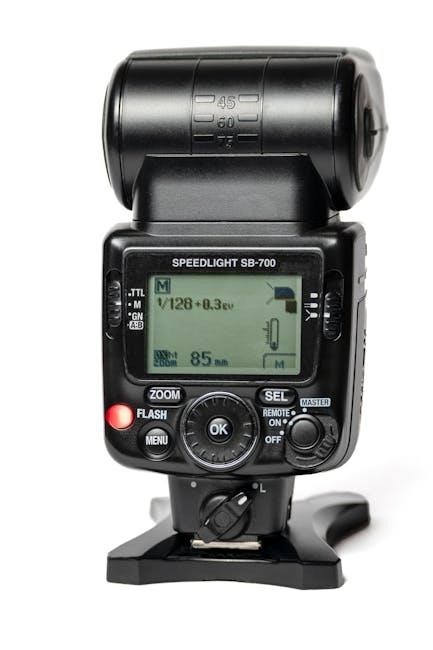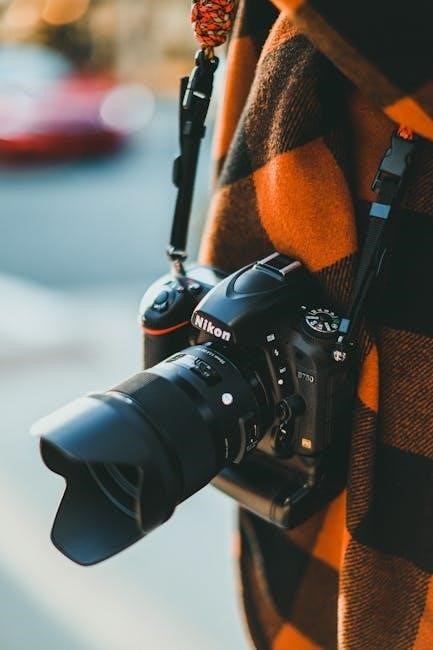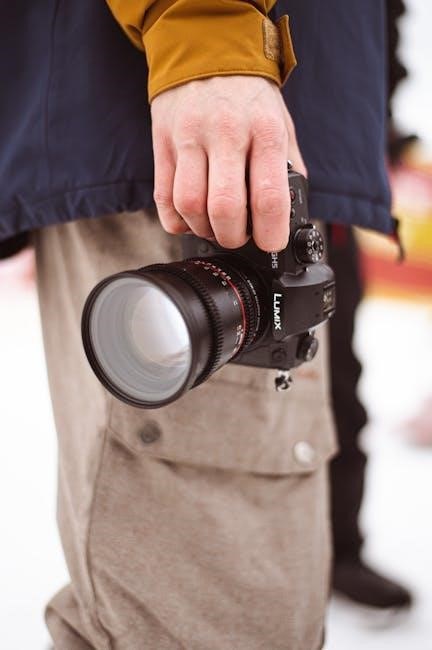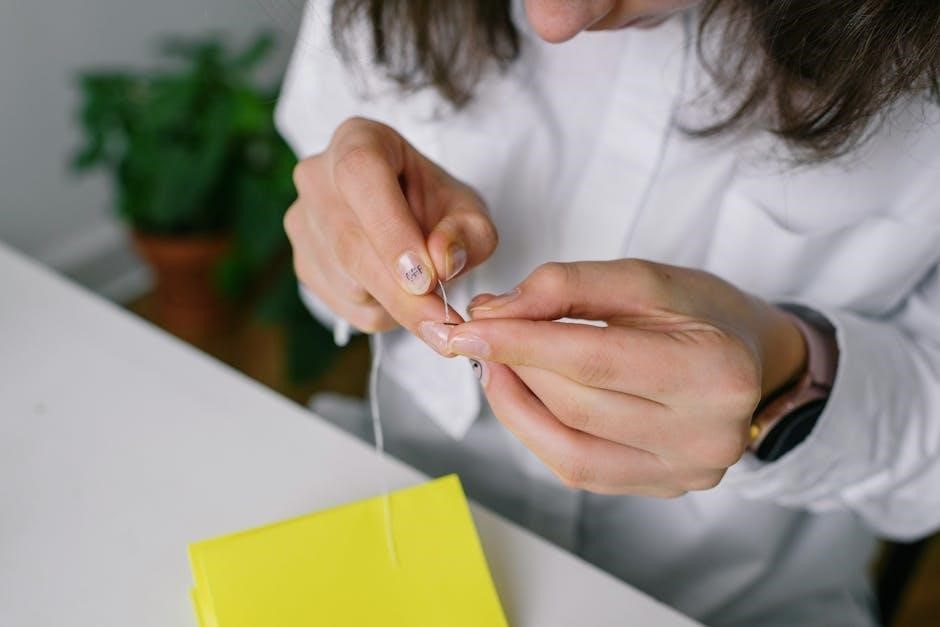
Welcome to the Nikon D3000 manual‚ your comprehensive guide to mastering this versatile DSLR camera. Designed for beginners‚ it covers essential features‚ shooting modes‚ and customization options‚ ensuring you unlock the camera’s full potential.
Overview of the Nikon D3000 DSLR Camera
The Nikon D3000 is an entry-level DSLR camera designed for beginners and photography enthusiasts. It features a 10.2-megapixel DX-format CCD sensor‚ delivering sharp and vibrant images. With an 11-point autofocus system and Scene Recognition‚ it ensures accurate focus and exposure. The 3-inch LCD screen allows for easy preview and playback. Lightweight and user-friendly‚ the D3000 offers Guide Mode to help newcomers master photography basics. Its compatibility with Nikon lenses and accessories makes it a versatile choice for growing skills. This camera balances simplicity and functionality‚ making it ideal for those starting their DSLR journey.
Importance of the User Manual for Beginners
The Nikon D3000 manual is a vital resource for newcomers to photography‚ serving as a gateway to understanding the camera’s functions and capabilities. It provides clear instructions on navigating menus‚ mastering shooting modes‚ and customizing settings. The manual also offers troubleshooting tips and explains advanced techniques in an accessible way. By following the guide‚ users can optimize their photography experience‚ unlocking the full potential of the D3000. It acts as a comprehensive learning tool‚ helping beginners transition smoothly from auto modes to manual controls and beyond.

Key Features of the Nikon D3000
The Nikon D3000 boasts a 10.2 MP DX-format CCD sensor‚ EXPEED image processing‚ an 11-point autofocus system‚ a 3-inch LCD display‚ and a Scene Recognition System for enhanced performance.
10.2 Megapixel DX-Format CCD Sensor
The Nikon D3000 features a 10.2-megapixel DX-format CCD sensor‚ designed to capture high-resolution images with vibrant colors and sharp details. With a maximum resolution of 3872 x 2592 pixels‚ this sensor delivers excellent image quality‚ suitable for both everyday photography and creative projects. The DX format ensures compatibility with Nikon’s wide range of DX lenses‚ while the CCD technology provides accurate color reproduction and impressive performance in various lighting conditions‚ making it ideal for entry-level photographers aiming to produce professional-grade results.
EXPEED Image Processing Engine
The EXPEED Image Processing Engine powers the Nikon D3000‚ enhancing image quality and performance. It efficiently manages color reproduction‚ contrast‚ and exposure‚ ensuring rich and vivid results. This engine also minimizes noise and optimizes processing speed‚ allowing for smoother operation during continuous shooting. With EXPEED‚ the D3000 delivers sharp‚ detailed images with accurate color balance‚ making it a reliable choice for photographers seeking consistent and professional-looking outcomes in every shot.
11-Point Autofocus System
The Nikon D3000 features an 11-point autofocus system‚ designed for fast and precise subject tracking. This system ensures sharp focus‚ even in challenging lighting conditions‚ by utilizing cross-type sensors for improved accuracy. The 11-point array provides wide coverage‚ allowing the camera to quickly lock onto subjects and maintain focus during dynamic movements. Whether capturing portraits or action shots‚ this advanced AF system delivers reliable performance‚ making it easier to achieve professional-quality results with every click.
3-Inch LCD Display
The Nikon D3000 is equipped with a 3-inch LCD display‚ providing a clear and detailed view of your images. This screen allows for easy previewing and reviewing of photos‚ ensuring you can assess composition‚ focus‚ and exposure accurately. The LCD’s size and clarity make it ideal for navigating menus and adjusting settings. Whether you’re reviewing your shots or setting up the camera‚ the 3-inch display offers a convenient and user-friendly interface‚ enhancing your overall shooting experience with the D3000.
Scene Recognition System
The Nikon D3000 features an advanced Scene Recognition System‚ powered by a 420-pixel RGB sensor. This technology enhances autofocus‚ auto exposure‚ and white balance accuracy by analyzing the scene and optimizing settings. It works seamlessly in various lighting conditions‚ ensuring precise and natural results. The system’s ability to recognize and adapt to different scenarios makes it a valuable tool for capturing stunning images with minimal effort‚ ideal for photographers of all skill levels.

Setting Up the Camera
Start by charging the battery‚ inserting the memory card‚ and attaching the lens. Power on the camera‚ set the language‚ date‚ and time for proper configuration and operation.
Charging the Battery and Inserting the Memory Card
Begin by charging the EN-EL9a battery using the supplied MH-23 charger until the indicator turns green. Next‚ insert a compatible SD or SDHC memory card into the camera’s card slot‚ located on the right side. Ensure the card is formatted in the camera menu to prepare for use. Avoid low battery levels during formatting to prevent data loss. Properly securing the battery and memory card ensures smooth operation and captures your moments flawlessly.
Attaching the Lens and Basic Camera Setup
Align the lens mount index with the camera’s white dot‚ then gently twist the lens clockwise until it clicks. Ensure the lens is securely attached. For lenses with an A-M switch‚ leave it at “A” for autofocus or move to “M” for manual focus. After attaching the lens‚ turn the camera on and set the time‚ date‚ and language in the menu. This basic setup prepares your Nikon D3000 for capturing high-quality images‚ ensuring optimal performance and ease of use.

Shooting Modes
The Nikon D3000 offers versatile shooting modes‚ including Auto‚ Guide‚ Program (P)‚ Shutter-Priority (S)‚ Aperture-Priority (A)‚ and Manual (M)‚ plus Scene Modes for creative control.

Understanding Auto Mode and Guide Mode
In Auto Mode‚ the camera automatically adjusts settings for focus‚ exposure‚ and ISO‚ making it ideal for beginners. Guide Mode provides interactive assistance‚ helping users understand and adjust settings like aperture‚ shutter speed‚ and ISO through simple prompts and visual guides‚ offering a learning experience without overwhelming complexity.
Program Mode (P)‚ Shutter-Priority Auto (S)‚ and Aperture-Priority Auto (A)
Program Mode (P) offers advanced auto shooting with user-adjustable settings. Shutter-Priority Auto (S) lets you set shutter speed to control motion effects‚ while Aperture-Priority Auto (A) allows you to adjust aperture for depth of field. These modes provide flexibility‚ enabling you to tailor settings while the camera balances exposure. They are ideal for transitioning from Auto Mode‚ offering creative control without manual adjustments‚ making them perfect for learning and refining photography techniques effectively.
Manual Mode (M) and Scene Modes
Manual Mode (M) offers full control over aperture‚ shutter speed‚ and ISO‚ allowing for precise adjustments to achieve desired effects. Scene Modes simplify shooting in specific situations‚ such as Portrait‚ Landscape‚ and Night Portrait‚ adjusting settings for optimal results. These modes help capture stunning images effortlessly‚ catering to both creative and practical needs‚ ensuring high-quality photography with minimal effort.

Custom Settings and Menu Functions
Customize your shooting experience with personalized settings and menu options‚ tailoring the camera to your preferences for enhanced control and optimal photography results.
Picture Controls and Active D-Lighting
Nikon’s Picture Control system allows you to customize image processing settings such as sharpening‚ contrast‚ and saturation to suit your creative vision. The D3000 offers six Picture Controls‚ enabling consistent results across devices. Active D-Lighting enhances detail in high-contrast scenes by adjusting highlights and shadows‚ ensuring balanced exposure. These features empower photographers to refine their images directly in-camera‚ delivering professional-quality results with minimal post-processing.
White Balance and ISO Sensitivity Settings
The Nikon D3000 offers versatile white balance options‚ including Auto‚ Daylight‚ Shade‚ and custom settings‚ ensuring accurate color reproduction in various lighting conditions. ISO sensitivity ranges from 100 to 1600‚ allowing photographers to capture sharp images in low-light environments while minimizing noise. These settings provide creative control‚ enabling adjustments to suit the scene‚ whether you’re shooting in bright sunlight or indoor settings‚ ensuring optimal image quality and flexibility for diverse photography needs.

Advanced Techniques
Explore advanced photography methods‚ including utilizing the built-in flash‚ mastering external flash setups‚ and applying exposure compensation for precise control over lighting and image results.
Using the Built-In Flash and External Flash
The Nikon D3000 features a built-in flash for convenient lighting in low-light conditions. To activate it‚ simply press the flash button on the camera. The flash automatically synchronizes with the 11-point autofocus system‚ ensuring balanced lighting. For advanced control‚ external flash units like the Nikon Speedlight series can be mounted‚ offering more creative freedom. Use the built-in flash for casual shots or external flash for professional results. Adjust settings like flash compensation to achieve desired effects in various lighting scenarios‚ ensuring sharp‚ well-lit images every time.
Understanding and Applying Exposure Compensation
Exposure compensation allows you to adjust the brightness of your images by +/-5 EV in 1/3 EV increments. Use the +/- button to fine-tune exposure for better results. This feature is especially useful in challenging lighting conditions‚ such as backlight or high-contrast scenes. When shooting in modes like P‚ S‚ or A‚ exposure compensation ensures your images are perfectly exposed. The D3000’s intuitive interface makes it easy to apply these adjustments‚ helping you capture stunning photos with precise control over lighting and contrast.

Caring for Your Camera
Regularly clean the camera and lens with a soft cloth to prevent dust and smudges. Store in a dry place‚ avoid extreme temperatures‚ and update firmware for optimal performance.
Cleaning the Camera and Lens
Regular cleaning is essential to maintain your Nikon D3000’s performance. Use a soft‚ dry cloth to gently wipe the camera body and LCD screen‚ removing dust and fingerprints. For the lens‚ start with a blower to remove loose particles‚ then use a microfiber cloth and lens cleaning solution. Avoid harsh chemicals or abrasive materials that could damage coatings. Always store the camera in a protective case to prevent scratches. Cleaning regularly ensures sharp images and prolongs the life of your equipment. A clean lens and camera body are crucial for optimal photo quality.
Updating Firmware and Maintenance Tips
Keep your Nikon D3000 up-to-date by regularly checking for firmware updates on Nikon’s official website. Updating firmware enhances camera performance‚ adds new features‚ and fixes issues. Use the camera’s menu to update via a memory card. Ensure the battery is fully charged to avoid interruptions. For maintenance‚ clean the camera and lens regularly‚ store it in a dry place‚ and format memory cards periodically. Check camera settings and battery health to ensure optimal functionality. Regular maintenance ensures your D3000 remains in top condition for years of reliable use.

Troubleshooting Common Issues
Resolve autofocus errors by cleaning the sensor and lens. Address error messages by restarting the camera or updating firmware. Check battery and memory card compatibility for optimal performance.
Resolving Autofocus Problems
Autofocus issues can often be resolved by cleaning the camera’s sensor and lens with a soft cloth. Ensure the lens AF/MF switch is set to AF. Restart the camera to reset settings. Check for firmware updates‚ as outdated software may cause focus errors. Verify that the lens is properly attached and compatible with the D3000. If problems persist‚ consult the troubleshooting section of the manual for advanced solutions or contact Nikon support for further assistance.
Fixing Error Messages and Camera Freeze
If your Nikon D3000 displays error messages or freezes‚ restart the camera by removing the battery and memory card for 10 seconds. Reinsert them and power on. Format the memory card in the camera to resolve card-related issues. Ensure the firmware is up-to-date‚ as outdated versions can cause malfunctions. Clean the lens and sensor to avoid focus errors. If problems persist‚ refer to the manual’s troubleshooting guide or contact Nikon support for professional assistance to restore functionality.

Additional Resources
Explore additional resources‚ including the Nikon Manual Viewer 2 app for digital access to your camera’s guide. Visit Nikon’s official website for online tutorials and expert tips to enhance your photography skills.
Downloading the Nikon Manual Viewer 2 App
The Nikon Manual Viewer 2 app is a convenient tool for accessing your Nikon D3000 manual digitally. Available for iPhones‚ iPads‚ iPod touch‚ and Android devices‚ this app allows you to download and view the camera’s manual offline. It’s perfect for quick reference on the go. The app is free to download and offers a user-friendly interface to navigate through the guide. Whether you’re a beginner or an experienced photographer‚ this resource ensures you always have the manual at your fingertips‚ empowering you to make the most of your Nikon D3000.
Accessing Online Tutorials and Guides
Supplement your learning with online resources tailored for the Nikon D3000. Nikon’s official website offers detailed guides‚ while platforms like YouTube host video tutorials covering camera setup and advanced techniques. Photography forums and communities provide tips and troubleshooting advice from experienced users. Additionally‚ websites like camerauserguide.net offer free PDF downloads of the manual in multiple languages. These resources complement the manual‚ helping you master the camera’s features and improve your photography skills effectively. They’re accessible anytime‚ making them invaluable for both beginners and enthusiasts.
The Nikon D3000 manual is an essential resource for mastering this entry-level DSLR camera. It guides users from basic setup to advanced techniques‚ ensuring a smooth learning curve. With its comprehensive coverage of features like autofocus‚ shooting modes‚ and customization options‚ the manual empowers photographers to unlock the camera’s full potential. By following the instructions and exploring online tutorials‚ users can enhance their skills and capture stunning images. Practice and experimentation will help you make the most of this versatile camera‚ turning your creative vision into reality.
Leave a Reply
You must be logged in to post a comment.